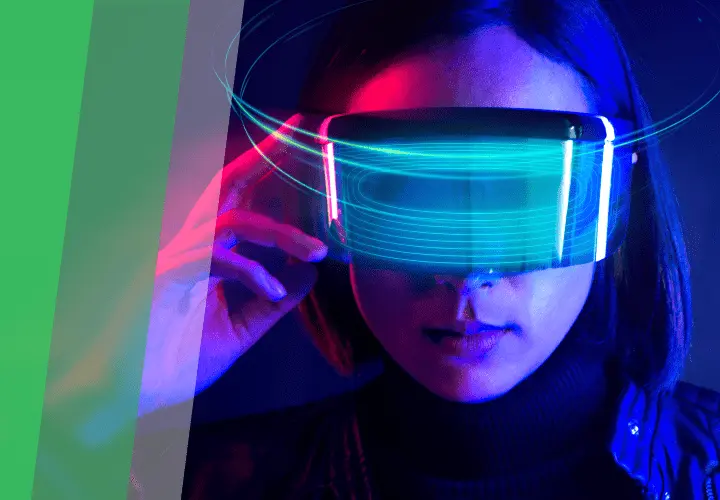The Future of Augmented Reality: A Vision for 2025-2030
Table of contents
- The AR/VR Market in 2025-2035
- The Overall AR & VR Market
- AR Individually
AR in the USA and Globally
- The Evolving AR Landscape: Hardware and Software Innovations
- The New Generation of AR Hardware: Beyond the Smartphone
The Continuing Relevance of Smartphone AR
The Power of AI in AR: Enabling Hyperrealism and Personalization
- Key AR Applications in 2025-2030
- Retail and E-commerce
- Gaming and Entertainment
- Education and Productivity
Integration into Daily Life
AR Growth Trajectory to 2025-2030
- User Base
Market Volume and Revenues
Industry Investment and Consumer Preferences
Challenges for Widespread Consumer AR Adoption in 2025-2030
Hardware Limitations (Battery Life, Weight, Cost)
Usability and Accessibility Issues
Infrastructure and Content
Privacy and Security
Seamless Blending of Realities in 2025 and Beyond
Observing the development of augmented reality in recent years, we've seen how rapidly it's transforming from a niche technology into a ubiquitous phenomenon. We encounter it increasingly in e-commerce and retail, where the rise of online shopping presents the challenge of remote selection. AR serves as a bridge, allowing consumers to try on, virtually place in their interiors, and better examine specific products from home, simplifying their choices without a physical store visit.
In this article, we'll take a broader look at AR technology, extending beyond the current year to examine its development trends through 2030.
The AR/VR Market in 2025-2035
The Overall AR & VR Market
Let's look at what's happening with the combined AR/VR market. Global revenues are projected to exceed $100 billion in 2025 and reach $200.87 billion by 2030, demonstrating a steady Compound Annual Growth Rate (CAGR) of 22% between 2025 and 2030. Moreover, this figure could grow to a staggering $589 billion by 2034.
AR Individually
The AR market alone is projected to reach $198 billion by the end of 2025, indicating its substantial individual trajectory. Mobile AR, in particular, is experiencing exponential growth, with its market volume estimated at $49.59 billion in 2025 and projected to reach approximately $529.93 billion by 2034, demonstrating a strong CAGR of 30.24%.
What should we pay attention to? Without a doubt, the market for active mobile AR users, where the number of active mobile AR users worldwide reached 1.7 billion by 2024 and is expected to exceed 2 billion by 2025.
AR in the USA and Globally
In the USA, the number of AR users reached 100.1 million in 2025, and is projected to be 103.9 million in 2026 and 106.9 million in 2027, respectively. This means that 75% of the global population will become active AR users by 2025, underscoring the ubiquity and broad reach of this technology.
Astonishing, isn't it? Looking at these figures, we see a fundamental shift in how consumers perceive and interact with AR. Moreover, the exponential growth in user numbers and market indicators, as well as the transition from 'novelty to necessity,' demonstrate that AR is becoming an integral part of daily life.
This broad reach, largely driven by mobile AR, lays the groundwork for the adoption and adaptation of more sophisticated AR devices like glasses, making 2025 a critical inflection point where AR truly enters the mainstream, with subsequent years leading up to 2030 characterized by further accelerated growth and integration. - Eric Johnson, Marketing Expert, Emerline
The Evolving AR Landscape: Hardware and Software Innovations
The New Generation of AR Hardware: Beyond the Smartphone
By 2025, AR glasses have evolved from conceptual prototypes to sophisticated devices poised to revolutionize daily life. Major tech companies are introducing cutting-edge AR glasses that combine style with enhanced functionality, making immersive experiences more accessible. Counterpoint Research estimates that global smart glasses shipments will significantly increase, from less than 3 million units shipped in 2024 to nearly 45 million units shipped annually by 2030.
- Apple Vision Pro: Launched in 2024, they mark a pivotal moment in AR's evolution. Designed as a "spatial computing device," they seamlessly blend digital and physical worlds, setting a standard for immersive experiences in 2025. The device continues to expand its capabilities with new features, app integrations, and developer support.
- Meta's Offerings:
- Meta Aria Gen 2 smart glasses are designed as a research platform for AR, AI, and robotics. They boast an improved eye-tracking system, blink detection, pupil center estimation, and four computer vision cameras for 3D hand and object tracking. Additional features include a photoplethysmography sensor for heart rate estimation, a contact microphone for cleaner audio in noisy environments, and an ambient light sensor to distinguish lighting conditions. They are lightweight, transmit data via a connected phone, and prioritize extended battery life.
- Meta Quest 3 (released in 2023) and the upcoming Meta Quest 4 (expected later in 2025) bring further shifts to the AR industry by offering headsets capable of both virtual and augmented reality. These devices feature next-gen Snapdragon XR processors, integrated AI for personalized experiences, and enhanced comfort through lighter, streamlined designs, promising deeper immersion with high-resolution OLED displays and advanced hand/eye tracking.
- Xreal's Focus on Affordability: Xreal has democratized AR hardware with its Air 2 Ultra glasses, offering a spatial computing experience at a fraction of the cost of competitors ($699). Their focus on compatibility allows for seamless integration with smartphones, tablets, and computers, further lowering the barrier to entry. The Xreal Beam Pro, launched in 2024, acts as a versatile controller and app hub.
- Samsung and Lenovo's Entry: Samsung's XR headset, developed in collaboration with Google and Qualcomm, combines Android XR, Snapdragon XR2 Gen 2 chipsets, and Samsung's design expertise, offering high-resolution displays and robust tracking. The Android XR hardware is expected to lead to platform rivalry among key players in 2025. Lenovo is also preparing an upcoming headset running on Horizon OS, designed to support both AR and VR, with an emphasis on integrated hand/eye tracking and high-resolution displays.
Further advancements in AR hardware are expected, with sleeker, more powerful devices that seamlessly integrate into daily life. Future smart glasses will offer enhanced AR experiences, better battery life, and more intuitive interfaces. Innovations in micro-displays, such as MicroLED, allow for extremely bright displays (>1 million nits) with ultra-low power consumption, which is critical for AI glasses with small form factors. Over time, these limited-field-of-view (FOV) glasses are expected to evolve into full-featured AR displays with wider FOVs (>70 degrees).
The market is diversifying, offering not only high-end specialized headsets but also more affordable options and research platforms. This multi-pronged approach indicates a strategy for broader market penetration, targeting diverse consumer segments and use cases. The emphasis on "sleeker, more powerful devices that seamlessly integrate into daily life" and "enhanced comfort and wearability" signifies a shift from novelty to practical, everyday utility.
The Continuing Relevance of Smartphone AR
Thanks to LiDAR on iPhones and evolving technologies on Android, smartphone AR is more powerful than ever, offering broader light detection and ranging capabilities to create AR experiences with greater depth. WebAR (web-based AR) lowers barriers to entry by allowing consumers to launch AR experiences with a simple QR code scan or link, eliminating the need for app downloads. Markerless AR can place 3D objects in space without special codes, and LiDAR enables more accurate room scanning.
While specialized AR glasses are the long-term vision, smartphones remain the immediate, ubiquitous platform for AR adoption. Advancements like LiDAR ensure that mobile AR continues to improve, serving as a crucial bridge and engagement mechanism for consumers before they invest in dedicated glasses. This dual-platform approach ensures continuous growth and a smoother transition for consumers into more immersive AR experiences.
The Power of AI in AR: Enabling Hyperrealism and Personalization
The integration of AI into AR/VR is set to drive significant advancements, enhancing rendering capabilities, tracking, and processing.
- Generative AI: Combining generative AI with AR in 2025 will improve digital world development, create better storylines, and, crucially, generate more realistic characters.
- Personalized Experiences: AI algorithms can create highly personalized experiences, with chatbot integration through AR technology being a notable advancement. Meta Aria Gen 2 glasses, for example, demonstrate groundbreaking AI capabilities, including a virtual memory system for finding lost items.
- Evolution of Spatial Computing: While spatial computing previously focused on headsets, 2025 will see a shift towards advancements in spatial computing displays that are not dependent on glasses, such as interactive billboards, holographic displays of real people, and even in-car windshield display systems.
- New Sensory Dimensions: The industry is working on incorporating scent into AR headsets and developing more realistic haptic gloves to provide sensations of weight and pressure, mimicking real interaction with virtual objects.
- AR Avatars and Virtual Beings: The rise of AR avatars and virtual beings is a key trend, with the US digital avatar market capturing over 82% of revenue in 2023. Companies like Snapchat and Instagram already allow users to apply various AR filters, while businesses use AR avatars for navigation and experience enhancement.
What's truly noteworthy is that AI is becoming a foundational layer for advanced AR experiences, enabling hyperrealism, dynamic content generation, and true personalization. This elevates the creation of rich and relevant content to an entirely new level.
The concept of 'spatial computing' is key here, signifying a move from screen-based interaction to engaging with digital content within our physical space, made possible by AI's understanding of that space. The emergence of new sensory inputs like scent and haptics indicates a drive towards truly multi-sensory immersion, blurring the lines between the digital and physical worlds.
This is a whole new reality, and it's just the beginning. - Eric Johnson, Marketing Expert, EmerlineKey AR Applications in 2025-2030
Undoubtedly, the period from 2025 to 2030 will see AR deeply integrated into daily life, transforming various aspects of the consumer experience. Its influence is felt across many sectors, from shopping to education and entertainment, demonstrating AR's maturity as a versatile tool.
Retail and E-commerce
AR has become a necessity in retail and E-commerce by 2025. According to Gartner, 80% of retailers will incorporate AR into their customer engagement strategy by 2025, with more than half of retailers planning new investments in AR/VR within two years.
One of the most revolutionary applications of AR is virtual try-on, which by 2025 has become mainstream in areas such as fashion, beauty, and furniture. Shopify merchants using AR try-ons report a reduction in returns alongside increased sales. For example, Nike reported an 11% increase in sales due to AR try-ons, while Gucci achieved a 188% increase in product page views and a 25% increase in purchase intent among those who used AR shoes. In physical stores, AR smart mirrors attract visitors by superimposing digital clothing or makeup, increasing fitting room traffic and delighting shoppers. AR storefronts and AR murals attract foot traffic, transforming passive glances from passersby into engaging moments that encourage shoppers to step inside. Brands utilizing AR storefront activations report significantly higher engagement rates (BrandXR notes up to 11 times more engagement compared to static displays).
Consumers are actively embracing AR in shopping. 61% of consumers prefer retailers offering an AR experience, and 71% stated they would shop more frequently if they used AR. 94% of consumers firmly agree that they will use AR at least as often as this year when shopping. AR can help address the $550 billion product returns problem, as consumers using AR for virtual try-ons are 25% less likely to return purchases. The AR shopping market is projected to grow from $4.0 billion in 2023 to $54.7 billion by 2033, reflecting a CAGR of 29.9%. Examples of popular AR applications include IKEA Place for furniture visualization and YouCam Makeup for virtual cosmetic try-ons. By 2027, over 50% of US consumers are expected to use AR for shopping.
The integration of AI and the widespread adoption of AR in social media are pushing the consumer experience towards hyper-personalization and deep interactivity. This shift transforms passive consumption into active participation, making AR a powerful tool for brand engagement and user-generated content. This effectively turns consumers into co-creators and marketers, amplifying "word-of-mouth" and boosting engagement.
Table 1: Overview of Leading Consumer AR Glasses (Key Features & Impact by 2025)
Device Name
Key Features
Source
Preference for retailers with AR
61% of consumers prefer retailers offering an AR experience
Willingness to shop more frequently with AR
71% of shoppers stated they would shop more frequently if they used AR
Confidence in product quality with AR
56% of consumers believe AR enhances their confidence in product quality
Willingness to pay more for AR-experienced products
40% of consumers are willing to pay more for a product if they can experience it using augmented reality
Increase in AR engagement since early 2020
Nearly 20%
Increase in conversion rate for AR users
90% for consumers interacting with AR compared to those who do not
Reduction in product returns due to AR
Consumers using AR for virtual try-ons are 25% less likely to return purchases; AR can help address a $550 billion return issue
For businesses, these figures serve as a clear justification for investing in AR, demonstrating a measurable return on investment through increased sales, reduced returns, and enhanced customer satisfaction. - Eric Johnson, Marketing Expert, Emerline
Gaming and Entertainment
The gaming and entertainment industry holds the largest share of the AR market, with a projected revenue of $11.6 billion in 2024. The global AR gaming market is estimated at $14.2 billion in 2024 and is projected to reach $141.7 billion by 2033, demonstrating a CAGR of 25.9%. Mobile AR games are also showing significant growth, from $4.2 billion in 2023 to $31.5 billion in 2033.
Niantic's Pokémon GO continues to evolve, offering new social and multiplayer AR features that keep attracting millions of players worldwide. AR filters and lenses on social media platforms like Snapchat and Instagram have become viral marketing tools, with over 300 million Snapchat users interacting with AR lenses daily. Social AR has become the new "word-of-mouth," as shoppers increasingly use social AR for product discovery and virtual try-ons. AR-enabled advertising often outperforms traditional ad formats. The future of entertainment also includes virtual concerts, attending social events and gatherings, and immersing oneself in magical landscapes. Generative AI is contributing to the creation of higher-quality storylines and realistic characters in AR games and entertainment.
Education and Productivity
The AR/VR market in education is estimated at $3.8 billion in 2023 and is projected to reach $14.2 billion by 2028, expanding at a CAGR of 29.6%. Wonderscope is revolutionizing children's education by combining storytelling with AR, allowing children to interact with animated characters and narratives, making learning engaging and fun. In medicine, AR is used for surgery planning and training, and VR training, as studies show, can improve test scores by 20%. The AR/VR market in healthcare is projected to reach $10.82 billion by 2025, and by 2032, the AR market in this sector could grow to $29.5 billion. By 2034, global VR/AR healthcare market revenue is projected to reach $14.85 billion.
For enhanced productivity, AR Ruler turns a smartphone into a virtual tape measure, particularly useful for professionals in construction, design, and real estate. SketchAR is a dream app for aspiring artists, overlaying virtual sketches onto real surfaces, allowing users to easily trace and learn drawing techniques. Google Lens has transformed how we search for information, providing instant information, translations, and shopping links by simply pointing a camera at an object. AR is also transforming remote collaboration and training in the corporate world, boosting efficiency and adaptability in the workplace. Remote AR assistance allows agents to show customers how to fix issues. Indoor AR navigation is also becoming achievable, providing precise directions inside buildings.
Integration into Daily Life
AR is also finding its way into everyday life, offering features such as real-time translation, navigation, tracking key health metrics for athletes, and summarizing meeting notes. These applications demonstrate how AR is moving beyond specialized use cases, becoming an integral part of daily tasks and enhancing them.
AR's impact is no longer limited to niche web applications; it's rapidly penetrating various consumer sectors, driven by tangible benefits like increased sales, reduced returns, and enhanced engagement. This widespread adoption signifies AR's maturity as a versatile tool, rather than just a novelty.
AR Growth Trajectory to 2025-2030
The augmented reality market is demonstrating unprecedented growth dynamics, confirmed by impressive user base figures, market volumes, and industry investments.
User Base
By 2025, the number of active mobile AR users worldwide is projected to exceed 2 billion, having reached 1.7 billion by 2024. In the USA, AR user numbers are forecast to hit 100.1 million in 2025, 103.9 million in 2026, and 106.9 million in 2027. Broader predictions suggest that 35-40% of internet users in the USA (approximately 60% of the total population) will regularly use AR by 2025. Notably, 75% of the global population will become active AR users by 2025. More than 300 million people daily use Snap's AR lenses, underscoring the ubiquity and widespread adoption of AR technologies.
The scale of projected user adoption indicates that AR is rapidly becoming a ubiquitous technology, moving beyond early adopters to widespread consumer familiarity. This broad reach, largely driven by mobile AR, creates fertile ground for the adoption of specialized AR glasses as they improve.
Market Volume and Revenues
Global AR/VR market revenues are projected to exceed $100 billion by the end of 2025, reaching $200.87 billion by 2030, demonstrating a CAGR of 22% between 2025 and 2030. By 2034, this figure could surge to a staggering $589 billion. The AR market alone is projected to reach $198 billion by 2025. The global mobile AR market volume will be $49.59 billion in 2025, and is forecast to reach $529.93 billion by 2034.
The consumer and enterprise AR glasses market was valued at $6.4 billion in 2024, and this figure is estimated to increase by over 50% by 2025. The AR glasses market will reach $883 million worldwide by 2025. By 2026, revenue from consumer and enterprise AR glasses (hardware and software) is expected to reach $35.06 billion.
AR in retail is predicted to be worth $12 billion by 2025, with the global AR shopping market growing to $54.7 billion by 2033. The global AR gaming market volume will be $14.2 billion in 2024, and is projected to reach $141.7 billion by 2033. The AR/VR market in healthcare is forecast to reach $10.82 billion by 2025, and by 2032, the AR market in this sector could grow to $29.5 billion. By 2034, global VR/AR healthcare market revenue is projected to reach $14.85 billion.
The overall AR/VR market is expected to nearly double between 2024 and 2028, with the AR/VR market CAGR projected to exceed 38% from 2023 to 2030. Brand spending on mobile AR marketing is forecast to grow from $5.51 billion in 2024 to $6.56 billion in 2025. Revenues from AR/VR advertising are projected to reach $8.8 billion by 2025.
Table 2: Key Consumer AR Market Projections (2025)Metric
2025
Global AR/VR Market Revenue
> $100 billion
Global AR Market Volume (AR only)
$198 billion
Global Mobile AR Market Volume
$49.59 billion
Global Active Mobile AR Users
> 2 billion
AR Users in the USA
100.1 million
AR Market Value in Retail
$12 billion
AR Glasses Market Value
$883 million
Industry Investment and Consumer Preferences
80% of retailers will implement AR by 2025, with 56% of retailers planning new investments in AR/VR by 2025. Major retailers like Walmart, Amazon, Target, and IKEA have already invested in AR capabilities.
Consumer preferences clearly lean towards AR. 61% of consumers prefer retailers offering an AR experience, and 71% stated they will shop more frequently if they use AR. 56% of consumers believe AR enhances their confidence in product quality, and 40% are willing to pay more for products experienced with AR. AR engagement has increased by nearly 20% since early 2020, and conversion rates have risen by 90% for consumers interacting with AR compared to those who don't. AR-enabled advertising often outperforms traditional ad formats. By 2026, 75% of global brands are expected to adopt some form of AR/VR for marketing.
Strong consumer preferences and a willingness to pay more for AR-enhanced experiences, combined with significant retailer investments, create a powerful feedback loop. Consumer demand pushes businesses to adopt AR, and business adoption, in turn, validates and normalizes AR for consumers, accelerating market growth and innovation. This indicates a self-sustaining cycle of adoption and investment.
Challenges for Widespread Consumer AR Adoption in 2025-2030
Despite rapid growth and immense potential, widespread consumer adoption of AR faces several significant obstacles that must be overcome for continued development through 2030 and beyond.
Hardware Limitations (Battery Life, Weight, Cost)
Wearable AR technologies haven't seen widespread adoption due to the weight and bulkiness associated with batteries and electronic components, as well as suboptimal processing power, battery life, and device brightness. AR glasses remain heavy and uncomfortable, still lacking adequate computational power, battery life, and brightness for an optimal user experience.
For instance, Meta Ray-Ban smart glasses typically provide approximately 4-6 hours of active use on a full charge and 14-16 hours on standby. Battery drain significantly depends on features used: photo and video capture consumes about 15-20% more power, voice commands 10-15%, music streaming can reduce overall battery life by up to 30%, and extended calls can reduce it by 20-25% per hour. External factors like extreme temperatures and high humidity also affect battery performance. Unstable Bluetooth connections increase battery consumption. The lithium-ion batteries in these glasses typically maintain optimal performance for about 2-3 years with regular use.
The cost of AR glasses ranges from $600 to $4000, which can be a significant barrier for the mass consumer market. The cost to develop a basic AR application ranges from $5,000 to $15,000 (marker-based), while complex markerless applications can cost $50,000 to $250,000 or more. Content creation costs, including 3D modeling, animation, and interactive elements, can range from $5,000 to over $50,000.
Usability and Accessibility Issues
New users encounter significant usability and accessibility challenges that hinder successful interaction with AR shopping platforms. These issues include overly complex navigation, difficulties operating the interface, and overwhelming cognitive load. Technical barriers include hardware device limitations, software performance problems, and unstable internet connections. Accessibility barriers include limited assistance for users with disabilities, a lack of alternative interaction approaches, and insufficient instructions. Users resist AR adoption due to confusing interfaces and poor navigation paths. The absence of suitable accommodations for users with disabilities leads to their exclusion from fully participating in AR shopping.
Infrastructure and Content
The lack of adequate internet infrastructure and reliable internet access is a significant barrier to AR adoption, especially in developing regions and for small businesses. Furthermore, there's limited availability of skilled personnel and technical expertise for developing high-quality AR content, particularly in generative AI for media and entertainment. The technical complexity of developing high-quality AR experiences is also an obstacle. To meet growing demand and leverage AR's potential, diverse and high-quality content is essential.
Privacy and Security
Privacy and security concerns remain relevant, as AR/VR applications collect vast amounts of user data to provide personalized experiences. Robust data protection measures and privacy-enhancing technologies are necessary. There are also regulatory challenges associated with generative AI in media and entertainment that require clear frameworks. Ensuring transparent data handling practices is crucial for building consumer trust.
Despite the 'main' barriers, there are certainly additional ones. These include insufficient technological awareness, both among potential users and small businesses. I'd emphasize that the long return on investment period for businesses, with significant initial investments and a lack of government support and clear policies that could facilitate AR technology adoption and regulation, is also not insignificant. - Eric Johnson, Marketing Expert, Emerline
Seamless Blending of Realities in 2025 and Beyond
By the end of 2025, augmented reality will be firmly established in the consumer landscape, transitioning from a futuristic concept to an everyday tool. The possibilities of AR seem limitless, and the rapid pace of innovation in AR/VR will become even more dynamic and integrated into our daily lives.
2025 is a crucial transition period, laying the groundwork for even deeper integration of digital and physical realities in the coming decade. Current advancements are fundamental steps towards a truly "seamless blending of realities." Within 5-10 years, AR glasses are expected to evolve into sleek, lightweight frames with capabilities surpassing modern smartphones. In the longer term, the integration of AR technology into contact lenses or implants could become a reality, leading to a seamless merging of physical and digital worlds. Future smart glasses will offer enhanced AR experiences, better battery life, and more intuitive interfaces. This is just a step towards spatial computing, where full-featured AR glasses can be used with a larger visual space for entertainment and much more.
The convergence of AR with AI is the primary driver of future innovation. AI will continue to enhance AR capabilities, making it more interactive and virtual environments more realistic. This promises not just visual overlays, but intelligent, adaptive, and personalized experiences that anticipate user needs. This synergy will open new horizons in usability and utility, making AR indispensable.
The AR/VR market is projected to reach $200.87 billion by 2030 and $589 billion by 2034. AR/VR is transforming industries, changing consumer behavior, and creating entire economies. 75% of global brands are expected to adopt some form of AR/VR for marketing by 2026. By 2030, AR and VR could contribute $1.5 trillion to the global economy and create 23 million jobs worldwide. Adopting AR is key to maintaining a competitive advantage in 2025 and beyond.
While challenges related to hardware limitations, usability, infrastructure, content, privacy, and security remain, continuous innovation and industry investment aim to overcome them. As AR becomes increasingly accessible, intuitive, and integrated into daily life, its potential to enrich the consumer experience will only grow, opening a new era of interaction with the digital world.
- Xreal's Focus on Affordability: Xreal has democratized AR hardware with its Air 2 Ultra glasses, offering a spatial computing experience at a fraction of the cost of competitors ($699). Their focus on compatibility allows for seamless integration with smartphones, tablets, and computers, further lowering the barrier to entry. The Xreal Beam Pro, launched in 2024, acts as a versatile controller and app hub.
Updated on Jun 21, 2025





